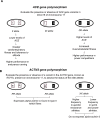Genetic aspects of athletic performance: the African runners phenomenon
- PMID: 24891818
- PMCID: PMC4037248
- DOI: 10.2147/OAJSM.S61361
Genetic aspects of athletic performance: the African runners phenomenon
Abstract
The current dominance of African runners in long-distance running is an intriguing phenomenon that highlights the close relationship between genetics and physical performance. Many factors in the interesting interaction between genotype and phenotype (eg, high cardiorespiratory fitness, higher hemoglobin concentration, good metabolic efficiency, muscle fiber composition, enzyme profile, diet, altitude training, and psychological aspects) have been proposed in the attempt to explain the extraordinary success of these runners. Increasing evidence shows that genetics may be a determining factor in physical and athletic performance. But, could this also be true for African long-distance runners? Based on this question, this brief review proposed the role of genetic factors (mitochondrial deoxyribonucleic acid, the Y chromosome, and the angiotensin-converting enzyme and the alpha-actinin-3 genes) in the amazing athletic performance observed in African runners, especially the Kenyans and Ethiopians, despite their environmental constraints.
Keywords: endurance runners; genes; genotype; physical exercise.
Figures

Similar articles
-
Kenyan and Ethiopian distance runners: what makes them so good?Int J Sports Physiol Perform. 2012 Jun;7(2):92-102. doi: 10.1123/ijspp.7.2.92. Int J Sports Physiol Perform. 2012. PMID: 22634972 Review.
-
East African runners: their genetics, lifestyle and athletic prowess.Med Sport Sci. 2009;54:102-109. doi: 10.1159/000235699. Epub 2009 Aug 17. Med Sport Sci. 2009. PMID: 19696510
-
Kenyan dominance in distance running.Comp Biochem Physiol A Mol Integr Physiol. 2003 Sep;136(1):161-70. doi: 10.1016/s1095-6433(03)00227-7. Comp Biochem Physiol A Mol Integr Physiol. 2003. PMID: 14527638 Review.
-
Effect of ACTN3 R577X Genotype on Injury Epidemiology in Elite Endurance Runners.Genes (Basel). 2021 Jan 8;12(1):76. doi: 10.3390/genes12010076. Genes (Basel). 2021. PMID: 33430120 Free PMC article.
-
A chronotype comparison of South African and Dutch marathon runners: The role of scheduled race start times and effects on performance.Chronobiol Int. 2015;32(6):858-68. doi: 10.3109/07420528.2015.1048870. Epub 2015 Jun 23. Chronobiol Int. 2015. PMID: 26102236
Cited by
-
A Medal in the Olympics Runs in the Family: A Cohort Study of Performance Heritability in the Games History.Front Physiol. 2018 Sep 18;9:1313. doi: 10.3389/fphys.2018.01313. eCollection 2018. Front Physiol. 2018. PMID: 30283357 Free PMC article.
-
Genetics and athletic performance: a systematic SWOT analysis of non-systematic reviews.Front Genet. 2023 Aug 9;14:1232987. doi: 10.3389/fgene.2023.1232987. eCollection 2023. Front Genet. 2023. PMID: 37621703 Free PMC article.
-
Responsiveness to endurance training can be partly explained by the number of favorable single nucleotide polymorphisms an individual possesses.PLoS One. 2023 Jul 20;18(7):e0288996. doi: 10.1371/journal.pone.0288996. eCollection 2023. PLoS One. 2023. PMID: 37471354 Free PMC article. Clinical Trial.
-
Control of Body Weight by Eating Behavior in Children.Front Pediatr. 2015 Oct 19;3:89. doi: 10.3389/fped.2015.00089. eCollection 2015. Front Pediatr. 2015. PMID: 26539422 Free PMC article. Review.
-
The Potential Role of Genetic Markers in Talent Identification and Athlete Assessment in Elite Sport.Sports (Basel). 2018 Aug 30;6(3):88. doi: 10.3390/sports6030088. Sports (Basel). 2018. PMID: 30200182 Free PMC article. Review.
References
-
- Matthews P. Athletics ’87: International Track And Field Annual. London: Simon and Schuster; 1987.
-
- Larsen HB. Kenyan dominance in distance running. Comp Biochem Physiol A Mol Integr Physiol. 2003;136(1):161–170. - PubMed
-
- Wilber RL, Pitsiladis YP. Kenyan and Ethiopian distance runners: what makes them so good? Int J Sports Physiol Perform. 2012;7(2):92–102. - PubMed
-
- Scott RA, Pitsiladis YP. Genotypes and distance running: clues from Africa. Sports Med. 2007;37(4–5):424–427. - PubMed
-
- Tucker R, Collins M. What makes champions? A review of the relative contribution of genes and training to sporting success. Br J Sports Med. 2012;46(8):555–561. - PubMed
Publication types
LinkOut - more resources
Full Text Sources
Other Literature Sources

